Land of Punt
The Land of Punt ( Egyptian: ![]()
 Egyptian empire (highlighted) with Punt in South-East corner (commonly agreed location) | |
| Geographical range | Eritrea |
|---|---|
| Dates | c. 2500 - 980 BCE |
| Preceded by | Qohaito |
| Followed by | D'mt |

At times Punt is referred to as Ta netjer (tꜣ nṯr), the "Land of the God".[9] The exact location of Punt is still debated by historians. Most scholars today believe Punt was situated to the southeast of Egypt, most likely in the coastal region of modern Djibouti, Somalia, northeast Ethiopia, Eritrea, and the Red Sea littoral of Sudan.[10] It is also possible that the territory covered both the Horn of Africa and Southern Arabia.[11][12] Puntland, the Somali administrative region situated at the extremity of the Horn of Africa, is named in reference to the Land of Punt.[13]
Egyptian expeditions to Punt
The earliest recorded ancient Egyptian expedition to Punt was organized by Pharaoh Sahure of the Fifth Dynasty (25th century BC), returning with cargoes of antyue and Puntites. However, gold from Punt is recorded as having been in Egypt as early as the time of Pharaoh Khufu of the Fourth Dynasty.[14]
Subsequently, there were more expeditions to Punt in the Sixth, Eleventh, Twelfth and Eighteenth dynasties of Egypt. In the Twelfth Dynasty, trade with Punt was celebrated in popular literature in the Tale of the Shipwrecked Sailor.
In the reign of Mentuhotep III (11th dynasty, ca. 2000 BC), an officer named Hannu organized one or more voyages to Punt, but it is uncertain whether he personally traveled on these expeditions.[15] Trading missions of the 12th dynasty pharaohs Senusret I, Amenemhat II and Amenemhat IV had also successfully navigated their way to and from the mysterious land of Punt.[16][17]
In the Eighteenth Dynasty of Egypt, Hatshepsut built a Red Sea fleet to facilitate trade between the head of the Gulf of Aqaba and points south as far as Punt to bring mortuary goods to Karnak in exchange for Nubian gold. Hatshepsut personally made the most famous ancient Egyptian expedition that sailed to Punt. Her artists revealing much about the royals, inhabitants, habitation and variety of trees on the island, revealing it as the "Land of the Gods, a region far to the east in the direction of the sunrise, blessed with products for religious purposes", where traders returned with gold, ivory, ebony, incense, aromatic resins, animal skins, live animals, eye-makeup cosmetics, fragrant woods, and cinnamon.[18][19] During the reign of Queen Hatshepsut in the 15th century BC, ships regularly crossed the Red Sea in order to obtain bitumen, copper, carved amulets, naptha and other goods transported overland and down the Dead Sea to Elat at the head of the gulf of Aqaba where they were joined with frankincense and myrrh coming north both by sea and overland along trade routes through the mountains running north along the east coast of the Red Sea.[20]
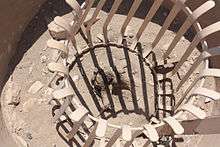
A report of that five-ship voyage survives on reliefs in Hatshepsut's mortuary temple at Deir el-Bahri.[21] Throughout the temple texts, Hatshepsut "maintains the fiction that her envoy" Chancellor Nehsi, who is mentioned as the head of the expedition, had travelled to Punt "in order to extract tribute from the natives" who admit their allegiance to the Egyptian pharaoh.[22] In reality, Nehsi's expedition was a simple trading mission to a land, Punt, which was by this time a well-established trading post.[22] Moreover, Nehsi's visit to Punt was not inordinately brave since he was "accompanied by at least five shiploads of [Egyptian] marines" and greeted warmly by the chief of Punt and his immediate family.[21][22] The Puntites "traded not only in their own produce of incense, ebony and short-horned cattle, but [also] in goods from other African states including gold, ivory and animal skins."[22] According to the temple reliefs, the Land of Punt was ruled at that time by King Parahu and Queen Ati.[23] This well illustrated expedition of Hatshepsut occurred in Year 9 of the female pharaoh's reign with the blessing of the god Amun:
Said by Amen, the Lord of the Thrones of the Two Land: 'Come, come in peace my daughter, the graceful, who art in my heart, King Maatkare [ie. Hatshepsut]...I will give thee Punt, the whole of it...I will lead your soldiers by land and by water, on mysterious shores, which join the harbours of incense...They will take incense as much as they like. They will load their ships to the satisfaction of their hearts with trees of green [i.e., fresh] incense, and all the good things of the land.'[24]

While the Egyptians "were not particularly well versed in the hazards of sea travel, and the long voyage to Punt, must have seemed something akin to a journey to the moon for present-day explorers...the rewards of [obtaining frankincense, ebony and myrrh] clearly outweighed the risks."[16][25] Hatshepsut's 18th dynasty successors, such as Thutmose III and Amenhotep III also continued the Egyptian tradition of trading with Punt.[26] The trade with Punt continued into the start of the 20th dynasty before terminating prior to the end of Egypt's New Kingdom.[26] Papyrus Harris I, a contemporary Egyptian document that detailed events that occurred in the reign of the early 20th dynasty king Ramesses III, includes an explicit description of an Egyptian expedition's return from Punt:
They arrived safely at the desert-country of Coptos: they moored in peace, carrying the goods they had brought. They [the goods] were loaded, in travelling overland, upon asses and upon men, being reloaded into vessels at the harbour of Coptos. They [the goods and the Puntites] were sent forward downstream, arriving in festivity, bringing tribute into the royal presence.[27]
After the end of the New Kingdom period, Punt became "an unreal and fabulous land of myths and legends."[28] However, Egyptians continued to compose love songs about Punt, "When I hold my love close, and her arms steal around me, I'm like a man translated to Punt, or like someone out in the reedflats, when the world suddenly bursts into flower."[29]
Ta netjer
At times, the ancient Egyptians called Punt Ta netjer (tꜣ nṯr), meaning "God's Land".[30] This referred to the fact that it was among the regions of the Sun God, that is, the regions located in the direction of the sunrise, to the East of Egypt. These eastern regions' resources included products used in temples, notably incense. Older literature (and current non-mainstream literature) maintained that the label "God's Land", when interpreted as "Holy Land" or "Land of the gods/ancestors", meant that the ancient Egyptians viewed the Land of Punt as their ancestral homeland. W. M. Flinders Petrie believed that the Dynastic Race came from or through Punt and that "Pan, or Punt, was a district at the south end of the Red Sea, which probably embraced both the African and Arabian shores."[31] Moreover, E. A. Wallis Budge stated that "Egyptian tradition of the Dynastic Period held that the aboriginal home of the Egyptians was Punt...".[32] However, the term Ta netjer was not only applied to Punt, located southeast of Egypt, but also to regions of Asia east and northeast of Egypt, such as Lebanon, which was the source of wood for temples.[33]
On the murals of the Hatshepsut temple at Deir el-Bahri, the King and Queen of Punt are depicted along with their retinue. Due to her unusual appearance, the Queen was sometimes hypothesized to have had advanced steatopygia[34] or elephantiasis.[35] However, she is now clinically recognized as having likely had the Queen of Punt syndrome, a suite of conditions that include familial obesity, Launois Bensaude lipomatosis, Dercum disease, neurofibromatosis, congenital lipodystrophy, achondroplasia, X-linked hypophosphatemia, and Proteus syndrome.[35]
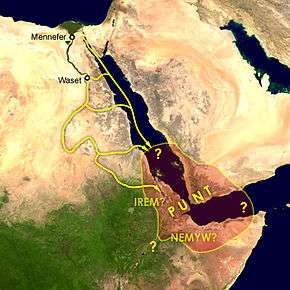
Proposed locations
Horn of Africa
The majority opinion places Punt in Northeastern Africa, based on the fact that the products of Punt (as depicted in the Hatshepsut illustrations) were abundantly found in the Horn of Africa but were less common or sometimes absent in Arabia. These products included gold and aromatic resins such as myrrh, frankincense, and ebony; the wild animals depicted in Punt included giraffes, baboons, hippotamuses, and leopards. Richard Pankhurst states: "[Punt] has been identified with territory on both the Arabian and the Horn of Africa coasts. Consideration of the articles that the Egyptians obtained from Punt, notably gold and ivory, suggests, however, that these were primarily of African origin. ... This leads us to suppose that the term Punt probably applied more to African than Arabian territory."[3][22][36][37]
In 2010, a genetic study was conducted on the mummified remains of baboons that were brought back from Punt by the ancient Egyptians. Led by a research team from the Egyptian Museum and the University of California, Santa Cruz, the scientists used oxygen isotope analysis to examine hairs from two baboon mummies that had been preserved in the British Museum. One of the baboons had distorted isotopic data, so the other's oxygen isotope values were compared to those of modern-day baboon specimens from regions of interest. The researchers at first found that the mummies most closely matched modern specimens seen in Eritrea and Ethiopia as opposed to those in neighboring Somalia, with the Ethiopian specimens "basically due west from Eritrea". The team did not have the opportunity to compare the mummies with baboons in Yemen. The scientists believed that such an analysis would yield similar results since, according to them, regional isotopic maps suggest that baboons in Yemen would closely resemble those in Somalia. Professor Dominy, one of the lead researchers, concluded from this that "we think Punt is a sort of circumscribed region that includes eastern Ethiopia and all of Eritrea."[38] In 2015, the scientists conducted a follow-up study to confirm their initial findings, and concluded that "our results reveal a high likelihood match with eastern Somalia and the Eritrea-Ethiopia corridor, suggesting that this region was the source of Papio hamadryas exported to Ancient Egypt."[39] In June 2018, Polish archaeologists who have been conducting research in The Temple of Hatshepsut since 1961 discovered the only depiction of a secretary bird (Sagittarius serpentarius) known from ancient Egypt in the Bas-reliefs from the Portico of Punt that depicted the great Pharaonic expedition to the Land of Punt. The secretary bird lives only in the African open grasslands and savannah, it is listed among the birds found in Sudan, Ethiopia, Eritrea, Djibouti, and Somalia, the bird is not found in Arabia.[40]
Recently it has been suggested that Punt might be located in the region of the Southwestern Sudan and nearby Eritrea where there flourished the Gash Group (about 3000 to 1800 BC) and later the Jebel Mokram Group. Especially at Gash Group site were found many Egyptian pottery vessels and Egyptian faience beads indicating close contacts with Egypt. Red Sea shells demonstrating contact with the Red Sea coast.[41]
Arabian peninsula
Dimitri Meeks disagrees with the Horn of Africa hypothesis and points to ancient inscriptions that locate Punt in the western coast of the Arabian Peninsula, from the Gulf of Aqaba to Yemen, he has written that "Texts locating Punt beyond doubt to the south are in the minority, but they are the only ones cited in the current consensus about the location of the country. Punt, we are told by the Egyptians, is situated – in relation to the Nile Valley – both to the north, in contact with the countries of the Near East of the Mediterranean area, and also to the east or south-east, while its furthest borders are far away to the south. Only the Arabian Peninsula satisfies all these indications."[11]
Others
Some scholars have argued that Punt is the early Pandyan island of Tamraparni, present day Sri Lanka.[42][43][44][45] An artefact datable to the Fifth Dynasty was originally stated to be made from Diospyros ebenum wood, a tree which is originary of Southern India and Sri Lanka. However, such identification is now considered unconfirmed because of the unlikelihood of such an early contact between Egypt and the Indian subcontinent, together with the difficulty of correctly identifying a plant specimen dead for thousands of years.[46][47][48]
Punt as depicted by Ancient Egypt
_-_TIMEA.jpg) Queen Ati and King Perahu of Punt and their Attendants as depicted on Pharaoh Hatshepsut's temple at Deir el-Bahri |
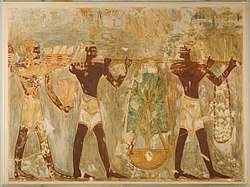 Men from Punt carrying Gifts, Tomb of Rekhmire |
Egyptian spelling "pwenet" the second "n" is a phonetic complement to "wen" and is not spoken the last sign is the determinative for country, land |
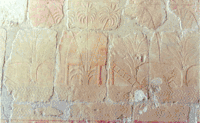 Wall relief |
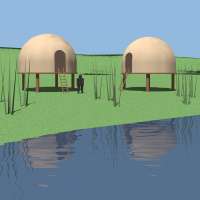 Huts as in relief |
See also
Notes
- http://digital.library.upenn.edu/women/edwards/pharaohs/pharaohs-8.html
- Ian Shaw & Paul Nicholson, The Dictionary of Ancient Egypt, British Museum Press, London. 1995, p.231.
- Shaw & Nicholson, p.231.
- "Punt". Ancient History Encyclopedia. Retrieved 27 November 2017.
- Flückiger, Friedrich August; Hanbury, Daniel (20 March 2014). Pharmacographia. Cambridge University Press. p. 136. ISBN 9781108069304.
- Wood, Michael (2005). In Search of Myths & Heroes: Exploring Four Epic Legends of the World. University of California Press. p. 155. ISBN 9780520247246.
opone punt.
- Albright, W.F (1922). "The Location of the Garden of Eden". American Journal of Semitic Languages and Literatures. 39 (1): 20. doi:10.1086/369964. JSTOR 528684.
- Sadler, Jr., Rodney (2009). "Put". In Katharine Sakenfeld (ed.). New Interpreter's Dictionary of the Bible. 4. Nashville: Abingdon Press. pp. 691–92.
- Breasted, John Henry (1906–1907), Ancient Records of Egypt: Historical Documents from the Earliest Times to the Persian Conquest, collected, edited, and translated, with Commentary, p.433, vol.1
- Simson Najovits, Egypt, trunk of the tree, Volume 2, (Algora Publishing: 2004), p.258.
- Dimitri Meeks – Chapter 4 – "Locating Punt" from the book Mysterious Lands", by David B. O'Connor and Stephen Quirke.
- Where Is Punt? Nova. http://www.pbs.org/wgbh/nova/ancient/egypt-punt.html
- Puntland profile, BBC News. https://www.bbc.com/news/world-africa-14114727
- Breasted 1906–07, p. 161, vol. 1.
- Breasted 1906–07, pp. 427–433, vol. 1.
- Joyce Tyldesley, Hatchepsut: The Female Pharaoh, Penguin Books, 1996 hardback, p.145
- El-Sayed Mahfouz: Amenemhat IV at Wadi Gawasis, Bulletin de l'Institut français d'archéologie orientale A. (BIFAO) 2010, vol. 110, [165-173, 485, 491 [11 p.], ISBN 978-2-7247-0583-6, see also
- Smith, Richard L. (2008). Premodern Trade in World History. Routledge. p. 45. ISBN 9781134095803. Retrieved 28 June 2019.
- Manansala, Paul (1994). The Naga race. University of Michigan: Firma KLM. p. 89. Retrieved 28 June 2019.
- Dr. Muhammed Abdul Nayeem, (1990). Prehistory and Protohistory of the Arabian Peninsula. Hyderabad. ISBN.
- Tyldesley, Hatchepsut, p.149
- Tyldesley, Hatchepsut, p.147
- Breasted 1906–07, pp. 246–295, vol. 1.
- E. Naville, The Life and Monuments of the Queen in T.M. Davis (ed.), the tomb of Hatshopsitu, London: 1906. pp.28–29
- Tyldesley, Hatchepsut, p.148
- Tyldesley, Hatchepsut, pp.145–146
- K. A. Kitchen, "Punt and how to get there", Orientalia 40 (1971), 184–207:190.
- Tyldesley, Hatchepsut, p.146
- O'Connor, David B (2003). Mysterious Lands. Routledge. pp. 88. ISBN 978-1844720040.
- Breasted 1906–07, p. 658, vol. II.
- 'A history of Egypt' Vol. I, p. 13 Moreover The Making of Egypt (1939) states that the Land of Punt was "sacred to the Egyptians as the source of their race."
- Short History of the Egyptian People, by E. A. Wallis Budge. Budge stated that "Egyptian tradition of the Dynastic Period held that the aboriginal home of the Egyptians was Punt..."
- Breasted 1906–07, p. 451,773,820,888, vol. II.
- D.W. Phillipson. 2005. African archaeology, page 81 of 389 pages
- Christenson, Bernard (May 2006). "Queen of Punt" (PDF). Journal of Clinical Infectious Diseases. 42 (9): 1344–5. doi:10.1086/503306. PMID 16586397. Retrieved 20 March 2017.
- Pankhurst, Richard (2001). The Ethiopians: A history. ISBN 978-0-631-22493-8.
- Hatshepsut's Temple at Deir El Bahari By Frederick Monderson
- Owen Jarus ,"Baboon mummy analysis reveals Eritrea and Ethiopia as location of land of Punt". The Independent. 26 April 2010. Retrieved 26 April 2010.
- NATHANIEL J. DOMINY1, SALIMA IKRAM, GILLIAN L. MORITZ, JOHN N. CHRISTENSEN, PATRICK V. WHEATLEY, JONATHAN W. CHIPMAN. "Mummified baboons clarify ancient Red Sea trade routes". American Association of Physical Anthropologists. Retrieved 14 June 2016.CS1 maint: multiple names: authors list (link)
- Zdziebłowski, Szymon (20 June 2018). "Polish Egyptologist discovered a secretary bird in the Temple of Hatshepsut". Science in Poland.
- Kathryn A. Bard, Rodolfo Fattovich (2018): Seafaring Expeditions to Punt in the Middle Kingdom Brill, ISBN 9789004368507, pp. 161-171
- Kuppuswamy (Prof.), T. V.; Kulkarni, Shripad Dattatraya; India), Shri Bhagavan Vedavyasa Itihasa Samshodhana Mandira (Bombay (1995). History of Tamilakam. Darkness at horizon. Shri Bhagavan Vedavyasa Itihasa Samshodhana Mandira. p. 71. Retrieved 30 June 2019.
- Pillai, Madhavan Arjunan (1988). Ancient Indian History. Ashish Publishing House. p. 223. ISBN 9788170241881. Retrieved 30 June 2019.
- Brahmavidyā: The Adyar Library Bulletin. Adyar Library and Research Centre. 1947. p. 40. Retrieved 30 June 2019.
- Stavig, Gopal (1989–1992). "Historical Contacts Between India and Egypt Before 300 A.D" (PDF). Journal of Indian History: 1–22. Retrieved 30 June 2019.CS1 maint: date format (link)
- Nicholson, Paul T.; Shaw, Ian; Press, Cambridge University (2000). Ancient Egyptian Materials and Technology. Cambridge University Press. p. 338. ISBN 9780521452571. Retrieved 28 June 2019.
- Lucas, A.; Harris, J. (2012). Ancient Egyptian Materials and Industries. Courier Corporation. p. 435. ISBN 9780486144948. Retrieved 28 June 2019.
- Burton, Anne (1973). Diodorus Siculus, Book 1: A Commentary. BRILL. p. 9. ISBN 9789004035140. Retrieved 28 June 2019.
References
- Bradbury, Louise (1988), "Reflections on Travelling to 'God's Land' and Punt in the Middle Kingdom", Journal of the American Research Center in Egypt, 25: 127–156, doi:10.2307/40000875, JSTOR 40000875.
- Breasted, John Henry (1906–1907), Ancient Records of Egypt: Historical Documents from the Earliest Times to the Persian Conquest, collected, edited, and translated, with Commentary, 1–5, University of Chicago Press.
- El-sayed, Mahfouz (2010). "Amenemhat IV au ouadi Gaouasis". BIFAO. 110: 165–173.
- Fattovich, Rodolfo. 1991. "The Problem of Punt in the Light of the Recent Field Work in the Eastern Sudan". In Akten des vierten internationalen Ägyptologen Kongresses, München 1985, edited by Sylvia Schoske. Vol. 4 of 4 vols. Hamburg: Helmut Buske Verlag. 257–272.
- ———. 1993. "Punt: The Archaeological Perspective". In Sesto congresso internazionale de egittologia: Atti, edited by Gian Maria Zaccone and Tomaso Ricardi di Netro. Vol. 2 of 2 vols. Torino: Italgas. 399–405.
- Herzog, Rolf. 1968. Punt. Abhandlungen des Deutsches Archäologischen Instituts Kairo, Ägyptische Reihe 6. Glückstadt: Verlag J. J. Augustin.
- Kitchen, Kenneth (1971), "Punt and How to Get There", Orientalia, 40: 184–207
- Kitchen, Kenneth (1993), "The Land of Punt", in Shaw, Thurstan; Sinclair, Paul; Andah, Bassey; et al. (eds.), The Archaeology of Africa: Foods, Metals, Towns, 20, London and New York: Routledge, pp. 587–608.
- Meeks, Dimitri (2003), "Locating Punt", in O'Connor, David B.; Quirke, Stephen G. J. (eds.), Mysterious Lands, Encounters with ancient Egypt, 5, London: Institute of Archaeology, University College London, University College London Press, pp. 53–80, ISBN 978-1-84472-004-0.
- Paice, Patricia (1992), "The Punt Relief, the Pithom Stela, and the Periplus of the Erythean Sea", in Harrak, Amir (ed.), Contacts Between Cultures: Selected Papers from the 33rd International Congress of Asian and North African Studies, Toronto, 15–25 August 1990, 1, Lewiston, Queenston, and Lampeter: The Edwin Mellon Press, pp. 227–235.
- O'Connor, David (1994), Ancient Nubia: Egypt's Rival in Africa, University of Pennsylvania Press, pp. 41–44.
- Wicker, F. D. P. (July, 1998), "The Road to Punt", The Geographical Journal. Vol. 164, no. 2. 155-167
Older literature
- Johannes Dümichen: Die Flotte einer ägyptischen Königin, Leipzig, 1868.
- Wilhelm Max Müller: Asien und Europa nach altägyptischen Denkmälern, Leipzig, 1893.
- Adolf Erman: Life in Ancient Egypt, London, 1894.
- Édouard Naville: "Deir-el-Bahri" in Egypt Exploration Fund, Memoirs XII, XIII, XIV, and XIX, London, 1894 et seq.
- James Henry Breasted: A History of the Ancient Egyptians, New York, 1908.
External links
- "Ancient African History: The Land of Punt". Archived from the original on 8 August 2007. with quotes from Breasted (1906) and Petrie (1939)
- Queen Hatasu, and Her Expedition to the Land of Punt by Amelia Ann Blanford Edwards (1891)
- "Deir el-Bahri: Mortuary Temple of Hatshepsut". Archived from the original on 30 November 2012.
- "Hall of Punt". Archived from the original on 22 October 2016. at Deir el-Bahri
- "Where was Punt?". Archived from the original on 5 March 2016. discussion by Dr. Karl H. Leser
- Queen of Punt syndrome
News reports on Wadi Gawasis excavations
- Archaeologists discover ancient ships in Egypt (Boston University Bridge, 18 March 2005). Excavations at Wadi Gawasis, possibly the ancient Egyptian port Saaw.
- Remains of ancient Egyptian seafaring ships discovered (New Scientist, 23 March 2005).
- "Sailing to distant lands". Al Ahram. 2 June 2005. Archived from the original on 23 September 2012.
- "Ancient ship remains are unearthed". Deutsche Press Agentur. 26 January 2006. Archived from the original on 8 December 2012.
- 4,000-year-old shipyard unearthed in Egypt (MSNBC, 6 March 2006).